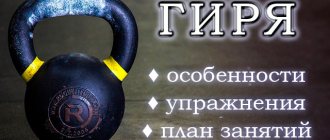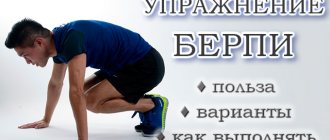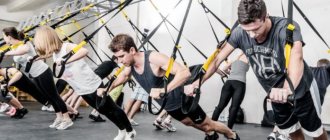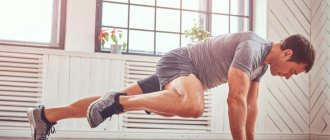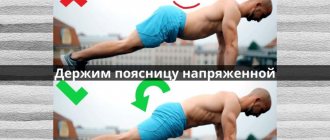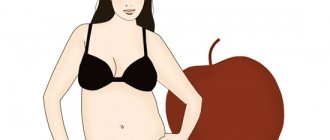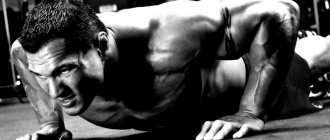Push-ups are a bodyweight strength exercise that are key to developing upper body muscles. Regularly performing push-ups not only increases your endurance and strengthens individual muscle groups, but also helps tone your entire body.
Do you want to learn how to do push-ups, are you looking for a ready-made diagram and the correct push-up technique? Or just want to know about the effectiveness of this exercise? We offer you the most complete guide to push-ups in one article, as well as step-by-step instructions on how to learn push-ups from scratch.
One-arm push-ups
For what: to increase the load.
Starting position: lying on your feet and one hand, the other behind your back. Feet slightly wider than shoulders, body weight on supporting arm.
How to do it : while inhaling, bend your arm at the elbow, lowering yourself down. As you exhale, return to the starting position. Perform by switching hands.
If your wrist joints hurt after push-ups, I advise you to pay attention to strengthening the muscles in this area. Exercises with a rubber expander, rotation of the hands, and bending of the wrist with a small load will help.
First block
Push-ups will differ, first of all, in the position of the hands.
- Classic push-ups with medium hand width.
Triceps and pectoral muscles work. - Push-ups with narrow arms.
The main load goes to the extensor muscles. Hands work along the body, elbows go back when performing. - Push-ups with hands placed wide on fingers.
The back muscles and shoulder delta work actively. - Push-ups with crossed palms.
The load goes to the triceps. - Deep push-ups until your shoulders touch your palms.
- Archer push-ups.
We place one hand wide and leave it straight when doing push-ups. The main load falls on the other hand. We perform it first on the right hand, and then on the left.
Photo: istockphoto.com
Push-ups: how to do them correctly
Push-ups are the most popular bodyweight exercise. It is used not only in strength training, but also in plyometric exercises, CrossFit, Pilates, callanetics and even yoga. And this versatility of push-ups is easily explained. Push-ups help you engage every muscle group from your neck to your toes, and especially strengthen your pectoral muscles, shoulder girdle, triceps, and abs.
There are many different types of push-ups, but before moving on to more complex modifications of this exercise, let's understand the technique of performing classic push-ups. The correct form of exercise is not only maximum results and high-quality muscle work, but also reduces the risk of injuries and damage during exercise.
Correct technique during classic push-ups:
- The body forms a straight line, the pelvis does not go up and does not bend down.
- The abdominal muscles are tense, but breathing is not held.
- The head is in a neutral position, not looking down, but not lifting up either.
- The palms are strictly under the shoulders and do not go forward.
- Palms face forward, parallel to each other.
- The elbows are turned back 45 degrees, they are not spread out to the side.
- As you inhale, bend your elbows and lower your body parallel to the floor, maintaining a straight body line.
- Push-ups are performed with full amplitude, i.e. the body drops as low as possible. Elbows should form a right angle.
It is this technique of classic push-ups that helps to evenly work the muscles of the shoulders, chest and triceps.
Push-ups work several muscle groups at once. This exercise allows you to work all the muscles of the shoulder girdle and the small stabilizing muscles of the shoulder. Also, push-ups from the floor and from the knees develop strength and elasticity of the shoulder muscles, which is especially important since the shoulder joint is extremely unstable and susceptible to displacement and injury.
Push-ups help work the following muscle groups:
- Pectoralis major muscle
- Deltoids (shoulders)
- Triceps
- Serratus anterior muscle
- Abdominal muscles
In addition, during push-ups, the muscles of the legs, buttocks and back are indirectly involved in the work. Push-ups also increase the functional strength necessary to perform regularly performed actions (lifting and moving objects, cleaning the house, holding a child in your arms).
At your fingertips
Some types of push-ups for different muscle groups for men are designed for complex levels of training. This type is an ideal way to strengthen the muscles of the forearms, hands, and chest. First you need to take a classic position while lying down, then place your hand touching the floor exclusively with your fingertips.
Differences from other types:
- in the lower position, the elbow bends at an angle of 90 degrees;
- the chest is held 4-5 cm above the floor, without touching the floor with the body;
- return to the original position is carried out only by pushes, an impulse emanating from the shoulder girdle.
This type of exercise is complex, so the muscles of the hands need to be well developed. It is important to warm up your fingers and wrists first.
With arms wide
Designed to train deep and superficial chest muscles. The main difference from the classical technique is that the arms are located almost 1.5-2 times wider than the shoulders. When bending, the torso should come into contact with the floor. This position requires fixation for several seconds. When returning to the starting position, it is necessary to tense the chest muscles.
Advice! At first, it will be difficult to learn a new technique and give commands to the body to tense the thoracic region. Therefore, it is better to first study the features of push-ups, do several approaches, and only after that connect brain control. Personal fitness training is great.
Expert advice
- Keep your body straight.
The most common mistake I see in gyms is allowing your hips to rise too high or drop too low. When you do a push-up, you must maintain a plank position so that your body creates one straight line that you lift and lower. - Move your shoulder blades: Ebenezer also noted that one of the most common mistakes when performing push-ups is trying to arch your back. This is absolutely not worth doing. If you do this, you will not be able to move your shoulders properly, which will make the push-up difficult. Rotator cuff problems can also develop because every time you do a push-up incorrectly, you force the shoulder joint to move in an unnatural way. Imagine having a nut between your shoulder blades that you need to squeeze as you lower yourself to the floor. Keep this picture in mind as you perform push-ups. As you lower yourself to the floor, tighten your back muscles, and then come back, unclenching your shoulder blades.
- Make sure you go low enough.
As you lower your body toward the floor, you must move through the entire range of motion and touch the floor, whether it be your nose, chest, or forehead. - If you cannot do the full amplitude, use a stand.
If you can't do full push-ups, find some kind of support, such as a chair, sofa or bench. Ab also believes that putting your knees on the floor when performing push-ups is not the best way to simplify the exercise, which is something people often try to do when mastering the movement, which is why they have difficulty transitioning from a knee push-up to a normal push-up. Much of the difficulty comes from not training the glutes and core enough and therefore lacking stability. Instead of starting your push-up journey from your knees, start on a bench - place your hands on the bench and perform push-ups. Slowly move from a high bench to a lower bench until you can perform push-ups. This will allow you to work with less load, but will not prevent you from training your core. At the gym, you can use a barbell to simulate push-ups.
How to learn to do push-ups from scratch
To learn how to do push-ups from scratch, you need to start with the preparatory period and follow the principle of progression.
The preparatory period lasts from three to six months. The rate of progression depends on the initial level of training.
Preparation period
Divide the preparatory period into two stages.
The first stage is introductory exercises. The second stage is classic push-ups.
The lead-in exercise is a lighter version of the exercise. The purpose of such a lesson: 1) master the technique; 2) prepare muscles, joints and ligaments for intense loads.
If you've never done 20 push-ups before, this is a problem, then start doing push-ups on the table. Increase the number of repetitions to 30 and move on to push-ups from a chair (sofa).
When 30 push-ups become an easy load, move on to the next stage.
How to progress as a beginner
Progress means constantly increasing or changing the load.
Learning to do 20-30 push-ups is not difficult. To increase the number of push-ups in one approach to 100 times or more, follow the principle of progression .
You can’t work until your muscles fail during your first workouts.
During the first training sessions, a beginner works at 50-70% of his capabilities. After each approach there should be a reserve of strength.
The beginner moves on to the next exercise, having completely restored his breathing. In addition, push-ups must be combined with other endurance exercises.
How to progress as a beginner?
For the first month, do not do “maximum” exercises. Starting from the second month of each workout, perform one approach until the muscles completely fail.
Head up and head down with support on a fitball or bench
- When resting your feet on a fitball or bench, your head will be located at or below your torso. Develops pectoral muscles, abdominal and arm muscles, triceps. Initial position: feet are on the fitball, hands rest on the floor, face is 3 cm from the floor. The support of the legs should be located under the feet. It is important to maintain balance.
- When resting your hands on a fitball or other object, in order to develop all muscle groups of the upper body, you need to kneel and then put your hands on it. The toes rest on the floor, the chest is located directly above the object. When bending, your elbows should be at a 90 degree angle.
These types of push-ups require constantly straining the body and controlling each muscle group. Therefore, you can start this push-up technique only after serious preparation, as you can injure your hips and arms.
Simplified push-up options for beginners
Beginners are not always able to perform even one push-up in the classic version.
In this case, two lightweight methods can help out. Knee push-ups. The starting position and execution technique are the same as in the basic version, but with emphasis on the knees and crossed legs.
Push-ups from the wall (table, bench). By changing the angle of inclination you can increase or decrease the load.
With support on one leg
Exercise for advanced level. It is required to maintain body stability, balance, and make much more effort. The starting position is the same as in the classical technique, but one leg should be on the other: only the toe of one foot touches the floor from below. Elbows should be kept as close to the body as possible. Lowering the body is done while inhaling; while exhaling, you need to push yourself off the floor.
Parallel bars training
Now it's time to move directly to the dip routines. It is important to be proficient in this exercise before attempting a workout consisting of dips alone.
I would like to believe that everyone, before using these sets of exercises, can already do 2-3 approaches of this exercise.
Now let's get down to business!
Program 1: Weight training
It should be understood that this program is designed to increase muscle mass, therefore, you need to consume more than you burn. Moreover, food should be balanced and not overloaded with fats and carbohydrates!
The program itself consists of:
- Warm up (run, jump, do some activity).
- Three sets of 10-15 repetitions with maximum weight (it is recommended to take two weights or dumbbells), rest between each approach for 2-3 minutes.
- Three sets of 10-15 repetitions with medium weights (one kettlebell or any other equipment), rest again for 2-3 minutes.
- Three sets of 10-15 reps with body weight.
- Push-ups with hands on some height to the maximum.
After such a workout, the pectoral muscles and triceps will be fully loaded. This dip routine should be performed 2-3 times a week for rapid chest muscle growth! Again, we must not forget about nutrition, in this case there will be no muscle growth!
Program 2: Ladder
This is a kind of variation of the ladder that is performed on the horizontal bar. Everything is very simple if you can do push-ups on the uneven bars. This set will work the triceps, pectoral muscles, as well as the abdominal muscles.
- First, two push-ups and two knee-to-chest raises are performed, then 4, 6, and so on.
- This number increases by 2 each time, reaching 20 push-ups and 20 knee trays.
Important condition: You cannot get off the bars! All this is done in one approach, but with a constant change of muscle groups.
The goal is to perform a total of 110 dips and 110 knee raises.
Program 3: Twenty weeks of push-ups
You need to do it every other day for 20 weeks! In one workout, 5 approaches are performed, with 10 repetitions in the first approach, and only 2 in the last. Over these twenty weeks of regular training, you need to increase the number of repetitions in the first approach to 70, and in the fifth to 25.
In order to gain muscle mass, you should use various types of weights, for example, water bottles, weights or dumbbells.
- The ideal would be to find a special belt from which you can hang a weight on a hook.
- It would also be better to constantly increase the load, starting from 3-5 kg and ending with 20-30.
- Although in this regard everything is individual and depends on the initial weight and level of training!
Regarding the bars, in principle, there is nothing more to add. It’s worth trying all the variations of this exercise, and then from all this choose the one you like the most. I would just like to wish everyone who reads this article success in their training. Let your muscle mass grow while doing these programs!
Sphinx
Rise from your elbows to your palms through your wrists (Photo: gymport.ru)
Such push-ups pump up the triceps well, and also help you learn to control your own body. Performed from the elbows:
- Take a prone position, but stand not on straight arms, but on your elbows. Palms face forward.
- Rise up onto your wrists and straighten your elbows.
- Stand on your palms and lower yourself back down onto your elbows.
The exercise is dynamic, without pauses or delays. Wrists work well. The body remains static.
What other types of push-ups do you know? Share in the comments.
With a narrow hand position
Also known as diamond exercises due to their excellent work on the deep pectoral muscles. At the same time, the technique itself is more reminiscent of a bench press.
Execution steps:
- Place your arms straight on the floor, with your index fingers and thumbs touching each other.
- Smoothly lower to the bottom position, lightly touching the floor.
- Actively push the body back to its original position.
- Tighten your muscles and hold static for a few seconds.
- Repeat the exercise.
This type of push-up is considered one of the hardest, as you need to properly redistribute the load and maintain balance. Therefore, a set of 10-15 push-ups should be done at the beginning of your workout for greater effectiveness.
Complex exercise options
Listed below are exercises of a high degree of difficulty designed to demonstrate the athlete's good level of physical fitness. Namely, strength, muscle development, the ability to maintain balance and coordinate the work of the whole body.
Here are some of these exercises:
- Hindu push-ups.
- One-arm push-ups.
- Planche (a version of push-ups without legs or in the horizontal).
In addition to complicating the technique of bodyweight push-ups, you can increase the load by doing the exercise with additional weights. For example, you can ask your partner to place a barbell plate on your back. If you do push-ups at home, the load can be an ordinary backpack. A special weighted vest would also be a good purchase.
When doing push-ups with weights, you need to especially carefully monitor the technique of performing the movement.
Types of push-ups
There are many varieties of push-ups depending on which muscle groups are emphasized. We must remember that you cannot thinklessly approach training and immediately try to perform exercises with weights or on weak muscles. The easiest consequence will be severe soreness a few hours after the approaches, but an unprepared person can also get serious injuries. It is better to start with classic push-ups, and after gradually strengthening the body, complicate the exercises and the load on the body.
Classic
The exercise technique is familiar from school physical education (the natural position of the body when a person wants to rise from such a position). The lying position is supported on the toes (feet together or slightly apart) and open palms. Place your palms slightly wider than your shoulders. The ideal execution is to touch the floor with your chest and chin, looking in front of you. The deltoid muscles, triceps, and deltoids are worked out. After a few weeks you can already increase the level of difficulty.
With weights
These push-ups are used by those involved in strength sports. Their focus is designed for the deep development of muscle tissue more than for the formation of relief. It is important to remember that weights cannot be done instantly, that is, on some day, add 10 kilos of additional weight to yourself in the approach. Ideally, when the load is increased, special vests are used, the weights of which can be changed (they are tailored to distribute the load throughout the body as comfortably as possible).
In the gym, you can use a barbell plate, which a partner will place on the trainee’s back and make sure that the load does not fall. A bench press with a girl lying on the athlete's back is often a simple show. Such an extra the load (40-50 kg) is actually beyond the strength of the average person. To reach this level, you need to train long and professionally.
Deep push-ups
This technique is designed for maximum efficiency in working out muscles with a large vertical amplitude. To do this, the level of the floor (the lowest point during the press) is lowered. In the gyms you can often find athletes who perform exercises using chairs or dumbbells with wide weights. This can cause injury because the supports are unstable. The ideal solution would be to purchase special handles from a sports store to increase the amplitude.
Slow push-ups
From the name it is clear that the exercise (of any type) is done at a slow pace. Its meaning is that endurance is trained without weights, and strength is trained with additional weight. The key to slow presses is continuity. This means that you do not need to stop at the bottom and peak points of the arm curl, but immediately begin the reverse movement. Each person chooses a speed different from standard push-ups, based on the fact that 8-10 repetitions should be done.
From my knees
A simplified form of classic push-ups, which is designed for beginners, older people and those who have contraindications to standard exercises. They differ from basic exercises in that the emphasis is not on the toes, but on the knees, while the feet need to be crossed. Studies have shown that the useful load on the spine is reduced by approximately 15%. The press itself is no different from regular push-ups.
Wide grip
To emphasize the load on the pectoral muscles, a wide grip is used: the hands rest on the floor at a distance twice as wide as the shoulders, the elbows diverge to the sides when lowering down. Weightening of this exercise occurs by raising your legs on a bench or stand. Raising the fulcrum of the feet 60 cm from the floor will increase the load to 75% of the athlete’s weight. It is important to constantly keep your back straight and not allow your stomach to sag, otherwise the meaning of the press is completely lost.
With a medium grip
This grip will help pump up your triceps if done correctly. The palms are positioned exactly shoulder-width apart, and when lowering the body, the elbows move parallel to the body, pressing as close to it as possible. Weightening or simplifying the exercise follows the same pattern as for classic push-ups (adding weights, raising the fulcrum of the legs or kneeling).
With a narrow grip
One of the most difficult push-up variations. The emphasis is on the palms (slightly turned outward), which are located at the point corresponding to the middle of the chest. Feet shoulder-width apart or slightly wider. At the lowest point, the sternum should touch the fingers. In this position, the exercise gives maximum load to the triceps and the front part of the deltoid muscle.
- Why take Aevit
- White lumps in the throat
- Symptoms of a sore throat
On one hand
Another difficult exercise designed for trained athletes. For those who are just starting training, it is better not to even try to do such a press, because there is a high probability of breaking the supporting arm. In this case, the person will simply hit his face on the floor from a height of half a meter. Correct execution: the supporting hand is in line with the body, the second is placed behind the back; legs spread wide to provide balance. At the lowest point, the chest touches the floor; in the reverse movement, the shoulders are kept parallel to the floor.
On fingers
This emphasis strengthens the hand and all its joints. The type of push-up in this case is not important (the only exception is a narrow grip, since it is extremely difficult to position your fingers comfortably). In order to understand whether you can do a push-up, you should stand for a while in the starting position. If your fingers are tired and start to hurt in the first seconds, then it is better to abandon the exercise and work with an expander to strengthen the hand.
Push-up program
A correctly designed system of push-ups is the number of approaches, alternating loads and rest, and frequency of execution. It will not only protect you from injuries during execution, but will also give maximum results. Ideally, the training program should be compiled by a professional trainer, based on the results of a test workout, but you can write it yourself. It is important to stick to the program and avoid skipping, incorrect loads, and alternate with strength exercises, otherwise the benefits will tend to zero.

